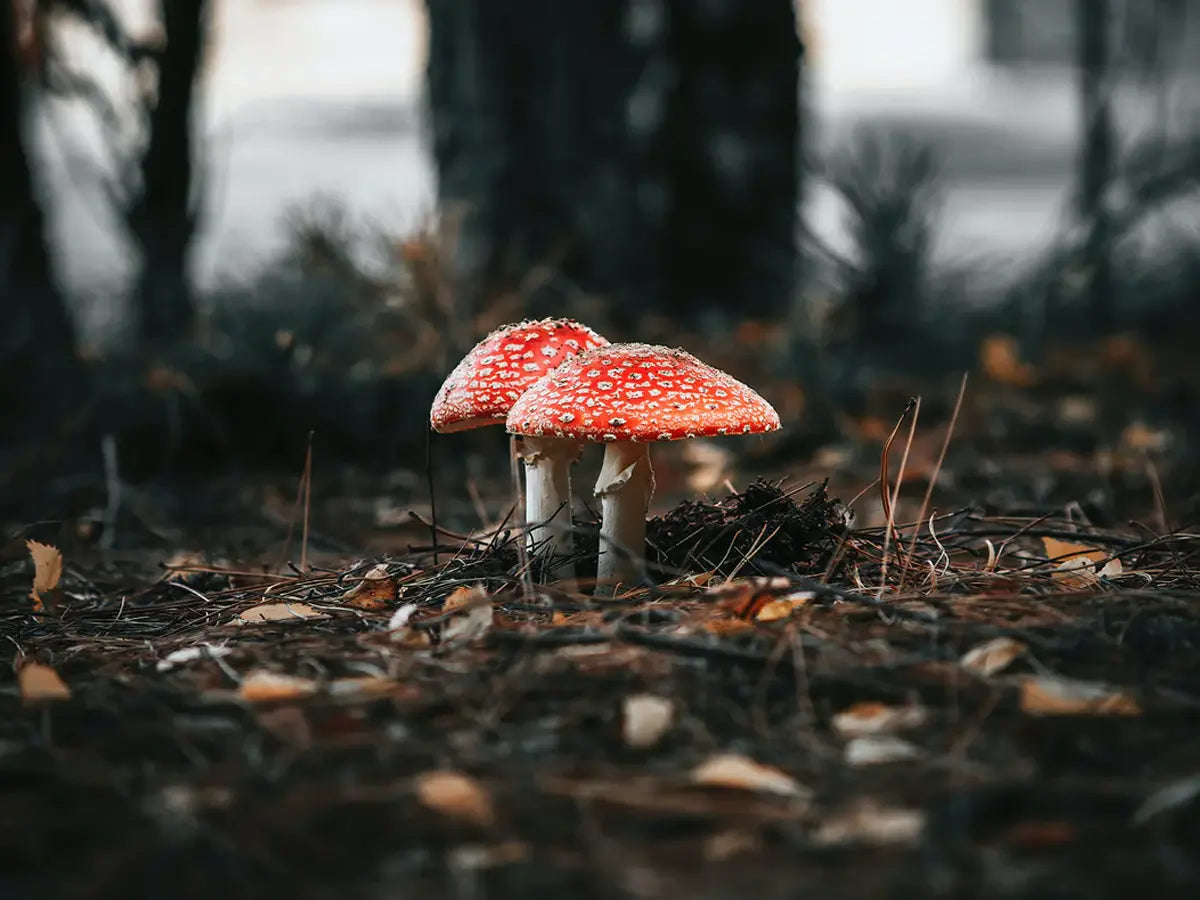Mycophobia: What's Beneath Britain's Historic Fear of Fungi?

Mycophobia, the deep-seated fear of mushrooms, has been a peculiar yet persistent aspect of British culture. Stemming from ancient folklore and a history peppered with cautionary tales, this unease around fungi has subtly influenced Britain's culinary habits and mycological enquiry. While modern understanding has begun to unravel many of these early apprehensions, the legacy of this long-standing skepticism continues to colour Britain's engagement with the fungal world. But is that now starting to change?
Historical Roots of British Mycophobia
The apprehension towards mushrooms in Britain has its origins in a complex interplay of folklore, historical events, and practical dangers. During medieval times, the mysterious nature of mushrooms, especially their ability to appear rapidly and in various unusual shapes, led to associations with witchcraft and supernatural forces. Fungi were often featured in folklore as ingredients in witches' brews or as markers of enchanted places, reinforcing their link to the mystical and unknown.

This mystical fear was compounded by real-world risks. The difficulty in distinguishing between edible and poisonous mushrooms presented a tangible danger. Historical incidents like the death of Roman Emperor Claudius, reportedly by the consumption of death cap mushrooms (Amanita phalloides), served as cautionary tales that permeated through the ages. These stories were not just anecdotal; they were often recorded in historical texts, further cementing the belief in the danger of mushrooms.
Moreover, the British Isles' native mushroom species include both innocuous and deadly varieties, such as the Fly Agaric (Amanita muscaria), known for its iconic red cap with white spots, and the aforementioned Death Cap. The presence of such potentially lethal species in the local flora contributed to a general wariness and avoidance of wild mushrooms.
These factors combined to create a cultural narrative where mushrooms were treated with suspicion and caution. This historical backdrop set the stage for the long-standing mycophobia in Britain, a sentiment that only began to shift with advances in scientific understanding and changes in cultural attitudes towards the natural world.
The Enlightenment and Persistent Mycophobia
The Enlightenment marked a pivotal period in the scientific study of the natural world, bringing fungi into the realm of formal inquiry. This era witnessed the pioneering work of mycologists like Elias Magnus Fries, often referred to as the father of mycology, who began the systematic classification and documentation of fungi. His work laid the foundation for understanding the diversity and complexity of mushrooms.
Despite these scientific advancements, the era did not immediately dispel the longstanding fears and superstitions surrounding mushrooms in Britain. The Victorian era, in particular, saw a surge in naturalistic studies and a growing interest in the classification and cultivation of mushrooms. Figures like Reverend M. J. Berkeley, a leading British mycologist of the time, made significant contributions to the field, yet the general public remained wary. The complexity of mushroom identification, coupled with the awareness of potentially fatal varieties like the Death Cap (Amanita phalloides), continued to fuel caution among the populace.
During this time, mycology was still in its infancy, and the lack of comprehensive, accessible knowledge meant that foraging and consumption of wild mushrooms remained a risky endeavor for the layperson. The Victorian fascination with natural history did bring mushrooms into the sphere of intellectual curiosity, but this was often overshadowed by the deep-rooted association of mushrooms with danger and deception.
Thus, this period represented a society in transition, where emerging scientific understanding began to challenge but not yet overcome the historical superstitions and fears. The legacy of these early scientific efforts, however, set the stage for a gradual shift in perceptions, paving the way for a more nuanced and informed relationship with fungi in the years to follow.

20th and 21st Century: Changing Perceptions
In the 20th and 21st centuries, the UK saw a notable shift in attitudes toward mushrooms, largely driven by evolving culinary trends and an increasing focus on sustainable and local food sources. This era witnessed the rediscovery and utilization of native British mushrooms like the Penny Bun (Boletus edulis), Chanterelles (Cantharellus cibarius), and Puffballs (Lycoperdon perlatum), known for their distinctive flavours and culinary versatility.
Parallel to this, the rise in vegetarianism and reduction in meat consumption have brought mushrooms to the forefront as a viable meat alternative. Their meaty texture, particularly in varieties like Portobello and Shiitake, made them popular in vegetarian and vegan dishes. This shift was not only a matter of taste but also a response to the environmental impact of meat production, with mushrooms emerging as a low-impact, sustainable food source.
Mushrooms in British Ecology
The ecological significance of mushrooms in the UK has gained greater recognition in recent decades, particularly their role in forest health and biodiversity. Fungi, especially mycorrhizal species like the Fly Agaric (Amanita muscaria) and Birch Polypore (Fomitopsis betulina), play a crucial role in supporting forest ecosystems. They form symbiotic relationships with trees and plants, facilitating nutrient exchange and enhancing soil quality. This symbiosis is vital for the growth of many native British trees, such as oaks and birches, which rely on these fungal networks for water and nutrient absorption.
In the realm of decomposition, species like the Stinkhorn (Phallus impudicus) and the King Alfred’s Cake (Daldinia concentrica) are instrumental. These fungi break down organic matter, recycling nutrients back into the soil, an essential process for forest regeneration and health. Their ability to decompose wood and leaf litter not only sustains the nutrient cycle but also aids in controlling disease spread by breaking down diseased plant material. This enhanced understanding of the ecological roles of fungi is influencing conservation efforts in the UK. Initiatives are increasingly focused on preserving fungal biodiversity, recognising that the health of forest ecosystems is intricately linked to the diversity and health of fungal populations. Conservation strategies are being adapted to include the protection of fungal habitats, acknowledging their indispensable role in maintaining ecological balance and supporting a diverse range of wildlife and plant species.
Future Role of Fungi in Britain
As Britain faces the challenges of environmental sustainability, the role of fungi is increasingly recognised as pivotal. In the field of bioremediation, certain fungi have shown remarkable capabilities in detoxifying contaminated soils and water. Species like the Oyster Mushroom (Pleurotus ostreatus) are known for their ability to break down petroleum and other toxic substances, offering a natural solution to pollution and land rehabilitation.
In agriculture, the efficiency and sustainability of mushroom cultivation are drawing attention. Utilising agricultural byproducts and waste materials, mushrooms can be cultivated with minimal environmental impact. This approach aligns with circular economy principles, where waste is minimised, and resources are reused. Cultivation of species like Shiitake (Lentinula edodes) and Lion's Mane (Hericium erinaceus) is becoming more prevalent, offering not only a nutritious food source but also contributing to sustainable agricultural practices.
The innovative use of fungal mycelium in materials science is another promising area. Research is underway to develop mycelium-based materials as alternatives to plastics and other pollutants. These materials are biodegradable and have a low carbon footprint, making them an attractive option for sustainable packaging and building materials. Mycelium's versatility and strength make it a potential game-changer in reducing environmental pollution and reliance on non-renewable resources.
These advancements in the use of fungi underscore their potential to be at the forefront of sustainable practices in Britain. Their ability to address environmental issues, contribute to sustainable agriculture, and innovate in material sciences positions fungi as key players in promoting environmental health and resource efficiency in the coming years.







